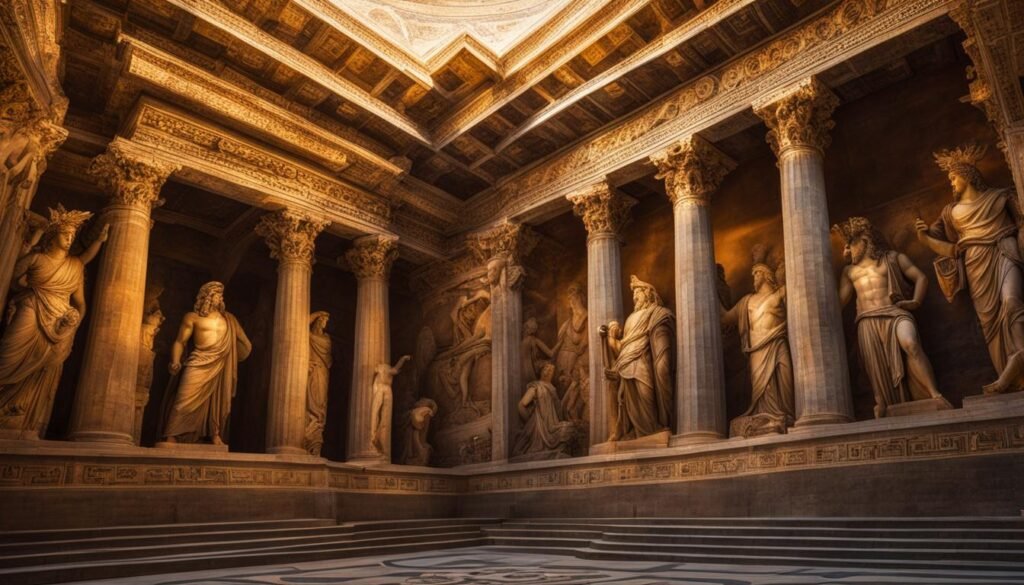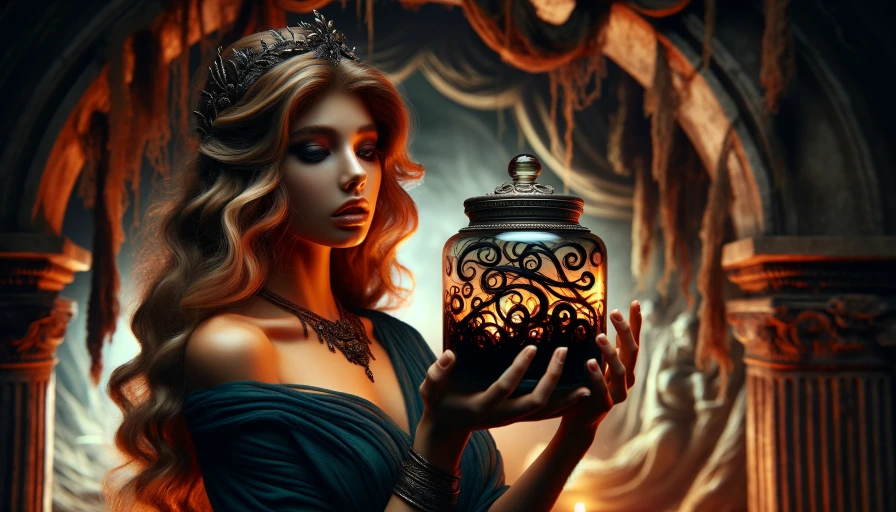Greek mythology has had a profound impact on the world of art. Throughout history, artists have drawn inspiration from the rich tales of Greek gods and heroes to create captivating works that explore themes of human nature, tragedy, beauty, and heroism. From ancient sculptures to contemporary interpretations, the influence of Greek mythology can be seen in various art forms.
Through the artistic depiction of mythological stories such as Pandora’s Box, Perseus and Andromeda, The Minotaur, Icarus, Leda and the Swan, and Achilles, artists have deepened our understanding of these ancient tales and invited us to reflect on the universal aspects of the human experience.
Key Takeaways:
- Greek mythology has been a constant source of inspiration for artists throughout history.
- Artistic representations of mythological stories explore themes of human nature, tragedy, beauty, and heroism.
- Artists have depicted mythological stories such as Pandora’s Box, Perseus and Andromeda, The Minotaur, Icarus, Leda and the Swan, and Achilles to create captivating works.
- The influence of Greek mythology can be seen in various art forms, from ancient sculptures to contemporary interpretations.
- The enduring impact of Greek mythology continues to shape and inspire the artistic panorama of today.
The Influence of Pandora’s Box in Art
The myth of Pandora’s Box has fascinated artists throughout history, inspiring numerous artistic interpretations. Pandora’s Box is a symbolic representation of the consequences unleashed by curiosity and the human desire for forbidden knowledge. Artists like Odilon Redon and David Medalla have explored the depths of this myth, using their artwork to comment on war, the complexities of the human condition, and the impact of everyday objects on our lives.
The Symbolism of Pandora’s Box
The artistic depictions of Pandora’s Box delve into the themes of temptation, curiosity, and the repercussions of our actions. These artworks serve as a cautionary reminder of the consequences that can arise from giving in to our desires and the inherent flaws of human nature. Pandora’s Box is often portrayed as a mysterious and beautifully adorned container, tempting and alluring in its forbidden contents.
Exploring Deeper Meanings
Artists explore the multifaceted symbolism of Pandora’s Box, highlighting the complex nature of human curiosity and the unforeseen consequences that can unfold. The artwork invites viewers to contemplate the choices we make and the impact they have on our lives and society as a whole. Through their artistic interpretations, artists provoke thought and reflection, urging us to consider the balance between our innate curiosity and the potential dangers of unchecked exploration.
Depicting Perseus and Andromeda in Art
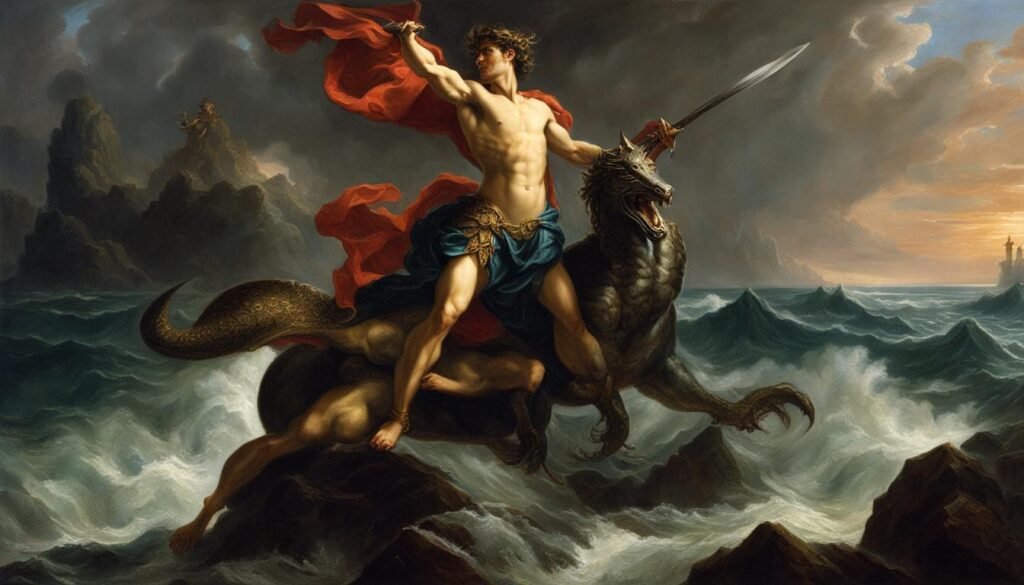
The story of Perseus and Andromeda, a tale of heroism and love, has captivated artists for centuries. This mythological story, which tells of Perseus’ courageous rescue of the princess Andromeda from a fearsome sea monster, has inspired countless artistic representations.
Throughout history, renowned painters like Peter Paul Rubens and David Gascoyne have brought this narrative to life on canvas, showcasing the triumph of good over evil and the power of mythological heroes. These artistic portrayals often highlight themes of bravery, love, and the enduring strength of the human spirit.
Artistic Interpretations of Perseus and Andromeda
- Painters like Peter Paul Rubens and David Gascoyne have depicted the heroic rescue of Andromeda, showcasing the triumph of good over evil and the power of mythological heroes.
- These artistic portrayals often highlight themes of bravery, love, and the enduring strength of the human spirit.
Through their art, these painters invite us to contemplate the timeless values and universal themes that Perseus and Andromeda represent. The beauty and passion captured in these artistic representations serve as a reminder of the remarkable capacity of art to transcend time and touch the depths of our souls.
The image above depicts the artistic representation of Perseus and Andromeda, a visual testament to the enduring allure of this mythological tale. In this interpretation, we see the hero Perseus in the midst of his valiant rescue, a symbol of courage and determination. The princess Andromeda, depicted with vulnerability and grace, represents the damsel in distress ultimately saved by her heroic savior.
By exploring the story of Perseus and Andromeda through art, we gain a deeper appreciation for the power of mythology to inspire and captivate. The artistic representations of this myth remind us of the timeless human qualities of bravery, love, and the indomitable spirit.
The Fascination with the Minotaur in Art
Throughout history, the mythical creature known as the Minotaur has captivated the imaginations of artists across the globe. Depicted as a half-man, half-bull figure, the Minotaur embodies themes of forbidden desire, violence, and the complexity of human nature. Artists such as Pablo Picasso and Leonora Carrington have explored the symbolism and psychological depth of the Minotaur, pushing the boundaries of artistic interpretation.
The Symbolism of the Minotaur
One of the reasons for the enduring fascination with the Minotaur is its rich symbolism. This mythical creature represents the darker aspects of humanity, confronting viewers with the animalistic instincts and desires that lie within us all. The Minotaur embodies the complexities of human nature, exploring the themes of power, desire, and the struggle between our civilized selves and our primal instincts.
Artistic Interpretation of the Minotaur
Artists have approached the depiction of the Minotaur in various ways, each conveying their unique interpretations. Pablo Picasso’s famous series of Minotaur paintings delves into the psychological turmoil and inner conflicts of the human psyche. Leonora Carrington, on the other hand, presents the Minotaur as a symbol of rebellion against societal norms and expectations. These artistic explorations challenge our preconceived notions of beauty and invite us to confront our own inner demons.
The fascination with the Minotaur in art continues to inspire contemporary artists, as they explore the complex interplay between darkness and light, desire and restraint, and the human and the animal. Through their artistic creations, they invite us to reflect on our own inner struggles and the hidden depths of the human condition.
The Tragic Tale of Icarus in Art

The tragic story of Icarus, the young man who flew too close to the sun and fell to his untimely demise, has captured the imaginations of artists throughout history. From ancient paintings to modern sculptures, Icarus has been a recurring theme in artistic representations. These depictions explore the themes of ambition, pride, and the consequences of overreaching.
The Icarus and Daedalus Myth
The myth of Icarus and his father Daedalus is a cautionary tale of hubris and the dangers of defying natural limits. In the myth, Daedalus constructs wings made of feathers and wax for himself and his son to escape the labyrinth they are imprisoned in. Despite his father’s warnings to fly at a moderate height and not too close to the sun or the sea, Icarus becomes enamored with the exhilaration of flight and ignores the advice. As a result, his wings melt when he gets too close to the sun, and he plummets into the sea. Artists have used this tragic tale to reflect on the consequences of unchecked ambition, the fragility of human existence, and the pursuit of grandeur at the expense of caution.
Artistic Interpretations
Throughout history, renowned artists have interpreted the story of Icarus in various mediums. Pieter Bruegel the Elder’s painting “Landscape with the Fall of Icarus” depicts a serene landscape scene with Icarus’ fall as a mere afterthought, symbolizing the indifference of the world to individual tragedies. In contrast, Henri Matisse’s sculpture “Icarus” captures the moment of Icarus’ fall, emphasizing the tragic nature of his fate. These artistic representations provoke contemplation on the risks and limitations of human ambition, reminding us of the delicate balance between aspiration and recklessness.
The Enduring Message
The tale of Icarus continues to resonate with audiences today, serving as a poignant reminder of the consequences of unchecked ambition and the human desire to soar beyond our limitations. Artists around the world have been captivated by this cautionary tale, using their creative expressions to warn against the perils of hubris and the dangers of ignoring wisdom. Through their artistic endeavors, they invite viewers to reflect on the universal aspects of the human experience and the delicate balance between reaching for the skies and staying grounded.
Leda and the Swan in Art
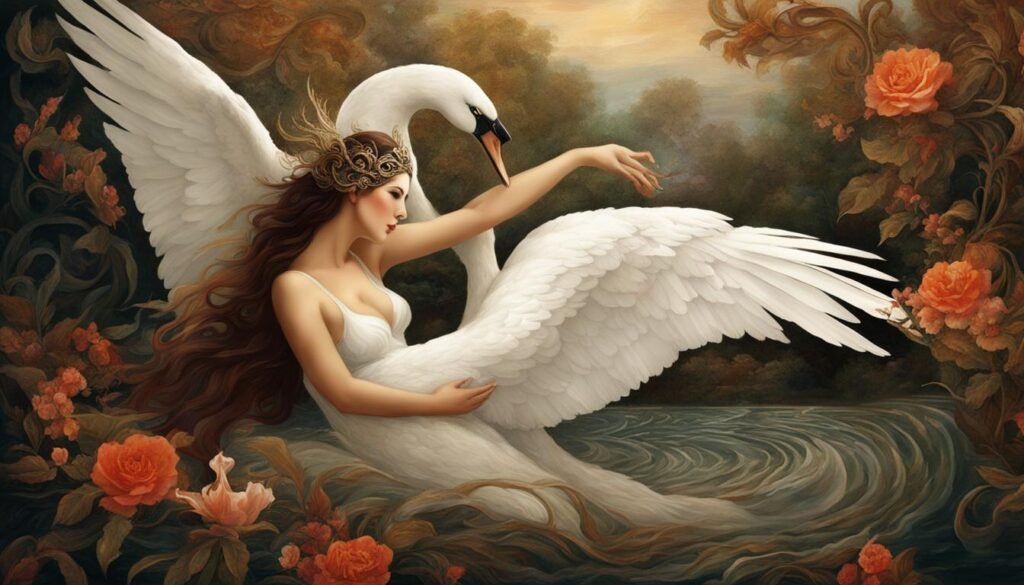
The myth of Leda and the Swan has captivated artists for centuries, inspiring them to depict the complex relationship between the divine and the mortal. In this myth, Zeus, the king of the gods, takes the form of a swan to seduce Queen Leda, leading to the birth of beautiful children who would play significant roles in Greek mythology.
Artists such as Leonardo da Vinci and Cy Twombly have explored the themes of desire, power, and the consequences of forbidden love in their depictions of Leda and the Swan. Their artistic interpretations challenge societal norms and delve into the complexities of human relationships, inviting viewers to contemplate the interplay between passion and consequence.
The artistic depictions of Leda and the Swan showcase the enduring fascination with this myth and highlight the timeless allure of Greek mythology in art. Through their creativity, artists have sought to capture the essence of this captivating story, inviting viewers to explore the depths of human emotion and the complexities of desire.
Artistic Depictions of Leda and the Swan
- Leonardo da Vinci’s painting, “Leda and the Swan,” portrays the intimate encounter between Leda and Zeus in a delicate and sensual manner.
- Cy Twombly’s series of paintings, known as the “Leda and the Swan” series, utilizes bold and expressive brushstrokes to convey the tumultuous nature of the myth.
- Other artists have explored Leda and the Swan through sculptures, drawings, and mixed media, each offering their own unique interpretation of this captivating myth.
The Heroic Feats of Achilles in Art

Achilles, the legendary hero of the Trojan War, has been a subject of great fascination for artists throughout history. From ancient Greek pottery to Renaissance paintings, artistic representations of Achilles showcase his heroic deeds and the tragic fate that awaits him. The artistic interpretations of Achilles delve into themes of heroism, fate, and the vulnerability of humanity.
One notable artistic depiction of Achilles is the sculpture “Achilles Dying” by French artist Jean-Baptiste Carpeaux. This masterpiece captures the moment of Achilles’ death, conveying both the physical pain and emotional turmoil of the hero. The sculpture is a poignant reminder of the cost of glory and the price heroes must pay.
The Symbolism of Achilles’ Shield
Another important representation of Achilles can be found in the shield he receives from the god Hephaestus in Homer’s Iliad. This shield is adorned with intricate scenes that symbolize various aspects of human life and the world. Artists such as Francesco Primaticcio and Nicolas Poussin have explored the symbolism of Achilles’ shield, using it to convey deeper meanings about war, society, and the human condition.
Embodying the Heroic Ideal
Achilles represents the epitome of the heroic ideal – a powerful warrior with unmatched bravery and skill. Artists have sought to capture this ideal in their portrayals of Achilles, emphasizing his physical prowess and the aura of divine grace that surrounds him. The artistic representations of Achilles remind us of the enduring allure of heroes and the timeless appeal of their stories.
The Influence of Greek Philosophy on Art
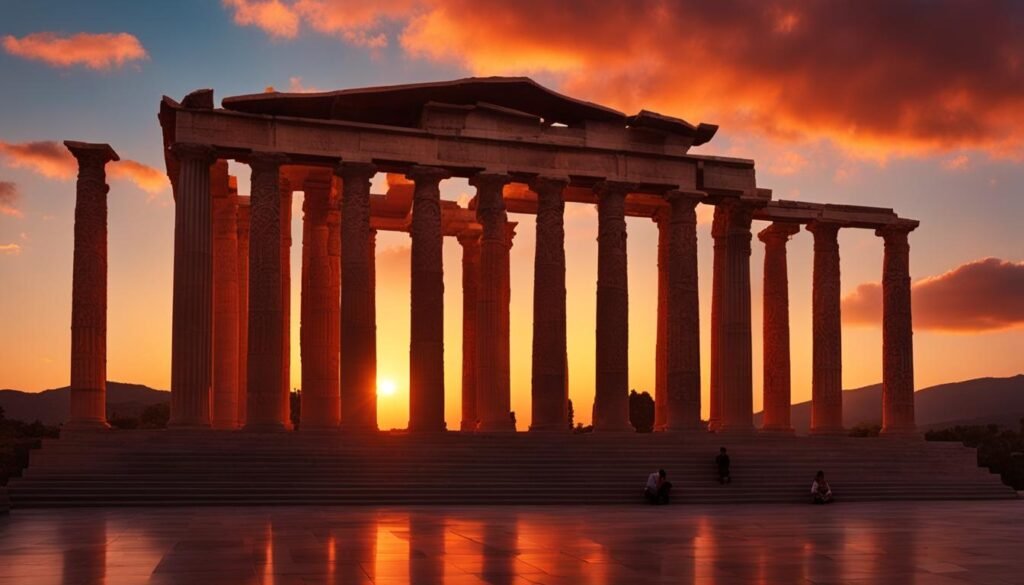
Greek philosophy has played a significant role in shaping the world of art. The theories put forth by philosophers like Plato and Aristotle have had a profound influence on artistic creation and interpretation throughout history.
Plato’s view of art as imitation and Aristotle’s focus on the essence and representation of the inner significance of things have provided artists with frameworks and concepts that continue to be explored in their work.
Exploring Realism and Abstraction
One of the key areas where Greek philosophy has influenced art is in the balance between realism and abstraction. Artists grapple with the challenge of representing the physical world accurately while also expressing the deeper emotional and intellectual truths behind it. This tension between the concrete and the abstract can be seen in various art forms, from classical sculpture to contemporary painting.
Self-Expression and Imitation
Another aspect influenced by Greek philosophy is the dichotomy between self-expression and imitation. Artists strive to convey their individual perspectives and emotions through their work, while also drawing inspiration from the world around them. The tension between these two impulses can be seen in the artistic choices made by creators throughout history, as they balance their own unique voice with the influence of artistic traditions and conventions.
The Search for the Ideal Form
The concept of the ideal form, a central tenet of Greek philosophy, continues to guide artists in their pursuit of aesthetic perfection. The Greeks believed in the inherent beauty of harmonious proportions and geometrical precision. This ideal can be seen in the meticulous attention to symmetry and balance in Greek architecture, sculpture, and painting.
In conclusion, Greek philosophy has had a lasting impact on the world of art. The exploration of concepts such as realism and abstraction, self-expression and imitation, and the search for the ideal form continue to shape artistic expression to this day. Artists draw upon the wisdom of ancient philosophers, infusing their work with deeper meaning and inviting viewers to contemplate the profound connections between art and philosophy.
The Aesthetic Principles of Ancient Greek Art
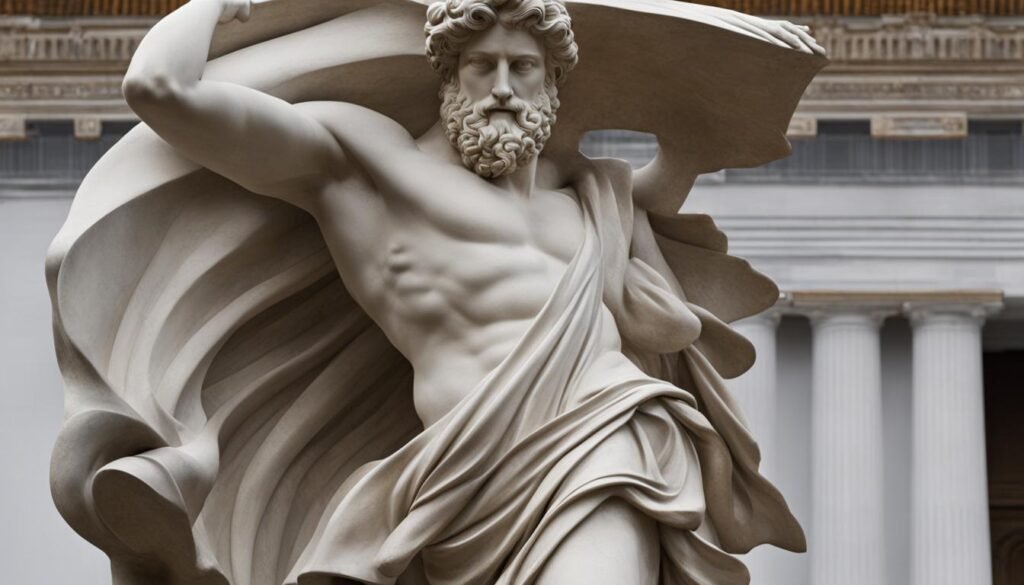
Ancient Greek art is known for its unparalleled beauty and exquisite craftsmanship. The artists of this era placed great importance on the aesthetic principles that guided their creations. These principles, which have influenced art throughout history, continue to inspire and captivate us today.
Balance and Proportion
One of the key aesthetic principles in Greek art is the emphasis on balance and proportion. The Greeks believed that harmony and symmetry were essential elements of beauty. In their sculptures and architectural designs, they sought to achieve a perfect balance between various elements. The use of mathematical formulas, such as the Golden Mean, helped artists ensure that their creations were visually pleasing and harmonious to the eye.
Geometry and Symmetry
Geometry and symmetry were fundamental to the aesthetic principles of Greek art. Artists meticulously incorporated geometric shapes and patterns in their artworks, creating a sense of order and precision. The symmetrical arrangement of figures and objects added to the overall harmony and balance of the composition. These geometric and symmetrical elements not only appealed to the Greeks’ sense of beauty but also conveyed a deeper understanding of the mathematical and philosophical concepts that underpinned their society.
Functionality and Beauty
In addition to balance and proportion, Greek art also emphasized the fusion of functionality and beauty. Whether it was a temple, a vase, or a piece of jewelry, every artwork had to be both aesthetically pleasing and serve a practical purpose. This integration of form and function resulted in artworks that were not only visually stunning but also served a useful role in everyday life. The Greeks believed that beauty should not be purely ornamental but should enhance the functionality and usefulness of the object.
These aesthetic principles of ancient Greek art continue to inspire artists and designers in various fields today. The notion of balance, proportion, geometry, and functionality can be seen in modern architecture, interior design, fashion, and even digital art. The timeless beauty and enduring impact of Greek art serve as a testament to the mastery and creativity of the ancient Greek artists.
The Evolution of Artistic Expression from Ancient Greece to the Modern Era
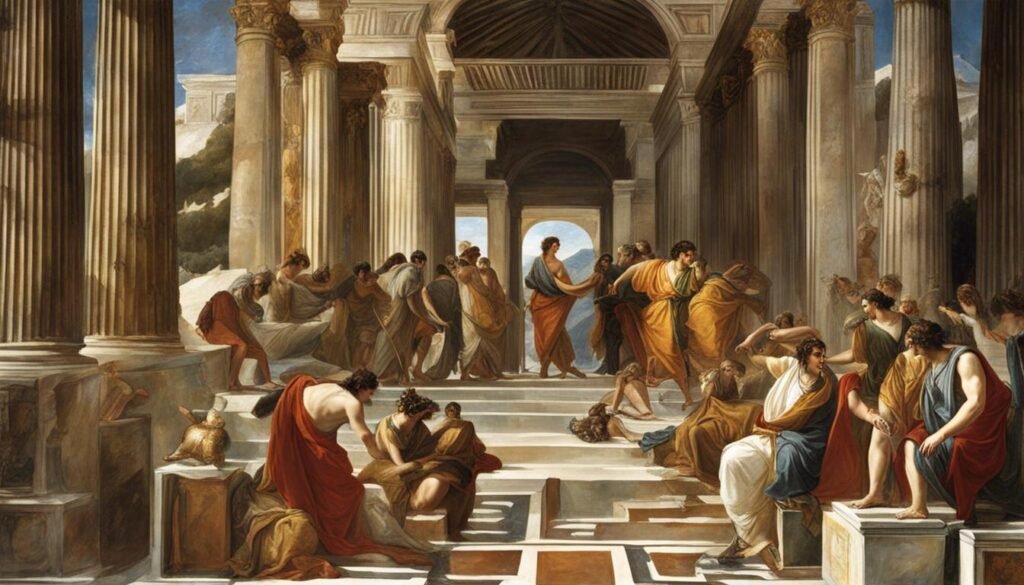
Throughout history, the influence of Greek art has permeated the artistic landscape, laying the foundation for the evolution of artistic expression. From the grandeur of ancient sculptures to the experimental works of the modern era, Greek art has served as a catalyst for innovation and creativity. The timeless themes and captivating stories of Greek mythology continue to inspire artists, providing a rich tapestry of ideas to explore.
One notable shift in artistic expression was seen during the Renaissance period, when artists began to look to ancient Greece for inspiration. The revival of classical ideals, such as balance, harmony, and proportion, brought forth a new wave of artistic exploration. Painters like Michelangelo and Raphael sought to capture the beauty and grace of the human form, echoing the aesthetic principles of ancient Greek art.
As the art world moved into the modern era, new movements emerged, each leaving its unique imprint on the artistic landscape. Impressionism, for example, revolutionized the way artists portrayed light and color, emphasizing the fleeting moments of everyday life. Artists like Claude Monet and Pierre-Auguste Renoir sought to capture the essence of a scene, using bold brushstrokes and vibrant palettes to evoke emotion and atmosphere.
The Evolution of Artistic Expression:
- Renaissance artists looked to ancient Greece for inspiration, incorporating classical ideals of balance, harmony, and proportion.
- Impressionism revolutionized the portrayal of light and color, capturing the fleeting moments of everyday life.
- Modern artists embraced abstraction, challenging traditional representation and exploring new avenues of creativity.
From abstract expressionism to pop art, artists of the modern era continued to push the boundaries of artistic expression. Figures like Jackson Pollock and Andy Warhol challenged traditional artistic norms, questioning the very definition of art itself. The evolution of art from ancient Greece to the modern era is a testament to the enduring impact of Greek art and the transformative power of artistic exploration.
The influence of Greek art has transcended time, shaping artistic expression throughout different eras. The rich mythology and philosophical concepts of ancient Greece continue to inspire artists, providing a wellspring of ideas and themes to explore. As we look to the future, it is clear that the legacy of Greek art will continue to influence and inspire artists, ensuring that art remains a reflection of the human experience.
Conclusion
Greek mythology has had a profound and enduring impact on the world of art. Throughout history, artists have drawn inspiration from the tales of gods, goddesses, and heroes, creating captivating works that explore the depths of human emotions and the universal themes of love, tragedy, and heroism.
From ancient sculptures to contemporary interpretations, Greek mythology continues to shape and inspire the artistic panorama of today. Artists have delved into the complexities of mythological stories, using symbolism and metaphor to comment on issues like war, the human condition, and the consequences of our actions.
Through their artistic endeavors, artists have captured the essence of mythological tales, inviting us to contemplate the timeless and universal aspects of the human experience. The impact of Greek mythology on art is undeniable, as it provides a rich tapestry of stories and themes that continue to resonate with audiences around the world.
FAQ
How has Greek mythology influenced art?
Greek mythology has long been a source of inspiration for artists throughout history, shaping the artistic landscape and exploring themes such as human nature, tragedy, beauty, and heroism.
How has the myth of Pandora’s Box been depicted in art?
Artists like Odilon Redon and David Medalla have explored the symbolism of Pandora’s Box, using it to comment on war, the human condition, and the impact of everyday objects. These artistic interpretations delve into themes of temptation, curiosity, and the consequences of our actions.
What is the significance of Perseus and Andromeda in art?
The story of Perseus and Andromeda, in which Perseus saves the princess Andromeda from a sea monster, has been a popular subject for artists. These artistic portrayals often highlight themes of bravery, love, and the power of mythological heroes.
How has the Minotaur been represented in art?
Artists like Pablo Picasso and Leonora Carrington have explored the symbolism of the Minotaur, representing themes such as forbidden desire, violence, and human nature. These artistic interpretations challenge our perception of beauty and societal norms.
How has the tragic tale of Icarus influenced art?
Painters like Pieter Bruegel the Elder and Henri Matisse have depicted the fall of Icarus, exploring themes of ambition, pride, and the consequences of overreaching. These artistic interpretations serve as cautionary tales, reminding us of the dangers of hubris and the fragility of human existence.
How has the myth of Leda and the Swan been portrayed in art?
Artists like Leonardo da Vinci and Cy Twombly have explored the complex relationship between the divine and the mortal, depicting themes of desire, power, and the consequences of forbidden love. These artistic interpretations challenge societal norms and delve into the complexities of human relationships.
How has the hero Achilles been depicted in art?
Artists like Barnett Newman and Gavin Hamilton have depicted the tragic fate of Achilles, showcasing themes such as heroism, fate, and the vulnerability of humanity. These artistic interpretations delve into the complexities of human nature and the struggles of the hero’s journey.
How has Greek philosophy influenced art?
Greek philosophy, particularly the theories of Plato and Aristotle, has greatly influenced the creation and interpretation of art. Artists have grappled with these philosophical concepts, exploring the balance between realism and abstraction, self-expression and imitation, and the search for the ideal form.
What were the aesthetic principles of ancient Greek art?
Ancient Greek art was driven by a pursuit of aesthetic perfection, with beauty, balance, proportion, and geometry held above all else. The principles of the Golden Mean and the application of mathematical proportions exemplify the Greek ideal of aesthetics.
How has artistic expression evolved from ancient Greece to the modern era?
The influence of Greek mythology and philosophy on art has transcended time, shaping artistic expression throughout different eras. Artists have continuously revisited and reinterpreted the themes and stories of ancient Greece, resulting in shifts in style, technique, and perspective.


